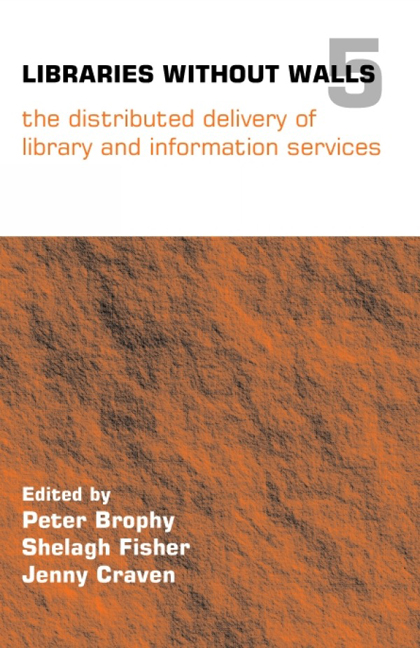Book contents
- Frontmatter
- Contents
- Contributors
- 1 Introduction
- 2 Keynote paper: beyond the mainstream of library services
- THEME 1 THE INTEGRATION OF LIBRARY SERVICES AND VIRTUAL LEARNING ENVIRONMENTS
- THEME 2 THE RELATIONSHIP BETWEEN USER NEEDS, INFORMATION SKILLS AND INFORMATION LITERACIES
- THEME 3 USABILITY AND ACCESSIBILITY OF DIGITAL LIBRARY SERVICES
- 12 An incremental usability and accessibility evaluation framework for digital libraries
- 13 Overcoming barriers to library use by Nigerian professionals
- 14 Digital library services at the Italian National Health Institute library
- 15 The information-deprived continent: can we do something?
- 16 Optimizing resource discovery service interfaces: the Library of Texas challenge
- THEME 4 DESIGNING THE INFORMATION ENVIRONMENT: NATIONAL AND INSTITUTIONAL PERSPECTIVES
- THEME 5 THE CREATION OF DIGITAL RESOURCES BY USER COMMUNITIES
- Index
- Miscellaneous Endmatter
- Miscellaneous Endmatter
- misc-endmatter
- Miscellaneous Endmatter
12 - An incremental usability and accessibility evaluation framework for digital libraries
from THEME 3 - USABILITY AND ACCESSIBILITY OF DIGITAL LIBRARY SERVICES
Published online by Cambridge University Press: 08 June 2018
- Frontmatter
- Contents
- Contributors
- 1 Introduction
- 2 Keynote paper: beyond the mainstream of library services
- THEME 1 THE INTEGRATION OF LIBRARY SERVICES AND VIRTUAL LEARNING ENVIRONMENTS
- THEME 2 THE RELATIONSHIP BETWEEN USER NEEDS, INFORMATION SKILLS AND INFORMATION LITERACIES
- THEME 3 USABILITY AND ACCESSIBILITY OF DIGITAL LIBRARY SERVICES
- 12 An incremental usability and accessibility evaluation framework for digital libraries
- 13 Overcoming barriers to library use by Nigerian professionals
- 14 Digital library services at the Italian National Health Institute library
- 15 The information-deprived continent: can we do something?
- 16 Optimizing resource discovery service interfaces: the Library of Texas challenge
- THEME 4 DESIGNING THE INFORMATION ENVIRONMENT: NATIONAL AND INSTITUTIONAL PERSPECTIVES
- THEME 5 THE CREATION OF DIGITAL RESOURCES BY USER COMMUNITIES
- Index
- Miscellaneous Endmatter
- Miscellaneous Endmatter
- misc-endmatter
- Miscellaneous Endmatter
Summary
Introduction
Information and Communication Technologies (ICTs) are enabling a global audience to share knowledge and ideas with one another by the click of a button. One of the key tools of this revolution is the internet, which is replacing CD-ROMs with online databases, traditional hard copy books and journals with digital libraries and atlases with interactive geo-spatial data. The success of these services is maximized if end-users are well supported to easily accomplish their desired tasks.
The nature of digital libraries
In recent years the information superhighway, the internet, has become a global gateway for information dissemination. With the ability to share worldwide collections of information, digital libraries (DLs) have become one of the common mediums to store and disseminate information by individuals or groups that select, organize and catalogue large numbers of documents.
DLs, generally referred to as ‘collections of information that are both digitized and organized’ (Lesk, 1997), give us opportunities we never had with traditional libraries or even with the web. Current design of DLs contains complex facilities including text search, functionality relating to hypertext, multimedia, the internet and highly interactive interfaces.
According to Theng (1997), if we have problems producing good websites (as evidenced by much research done in addressing problems on the web), then because DLs are more than just websites, we can expect to have problems creating good DLs too. Also, Dix et al. (1995) suggested that even if the best methodologies and models are adopted in the design of a usable interactive system, it is still necessary to assess the design and test the system to ensure that it behaves as expected and meets the user's requirements. Therefore, there is a need for a usability and accessibility framework that supports the development of effective solutions for DLs in order to produce truly usable and accessible DLs.
A crucial factor for libraries is that the information they preserve and deliver must be effectively organized. With regards to DLs, Arms (2002) notes that a ‘(d)igital stream of data sent to earth from a satellite is not a library. [However, the] same data, when organized systematically, becomes a digital library collection.’ This is one of the key dimensions of a DL.
- Type
- Chapter
- Information
- Libraries Without Walls 5The Distributed Delivery of Library and Information Services, pp. 123 - 131Publisher: FacetPrint publication year: 2004
- 7
- Cited by

